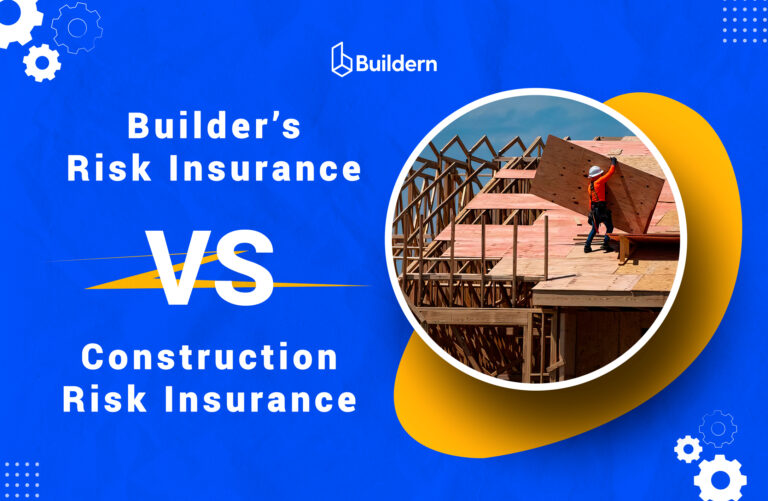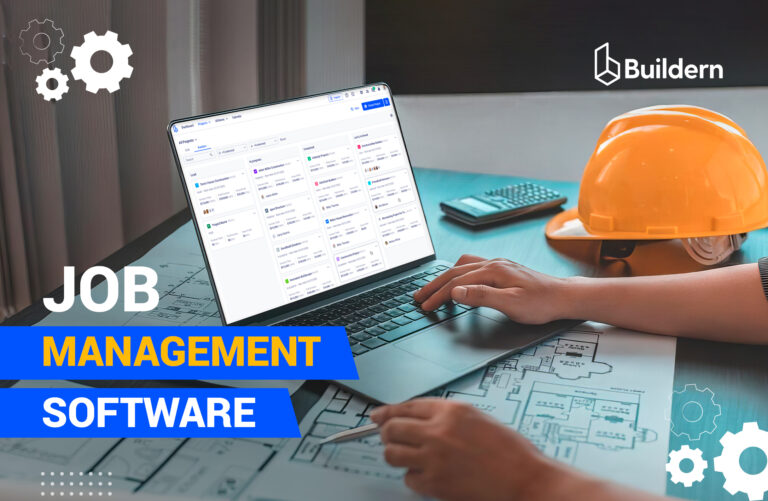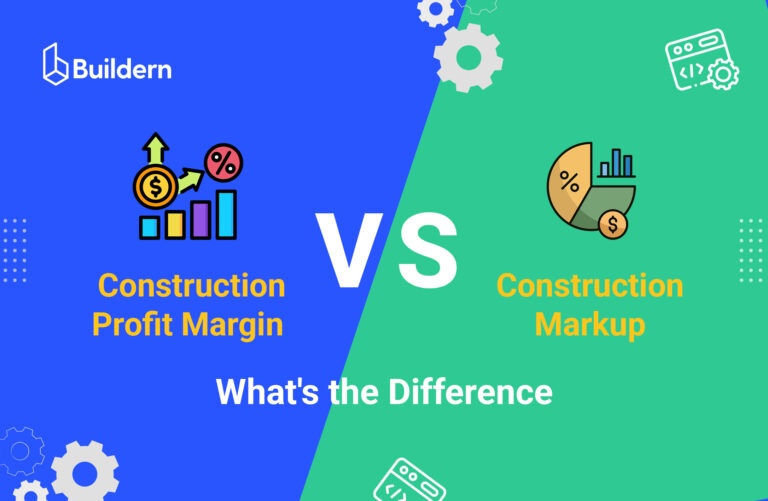Client Selections Process: How to Keep Track of Choices and Approvals Digitally
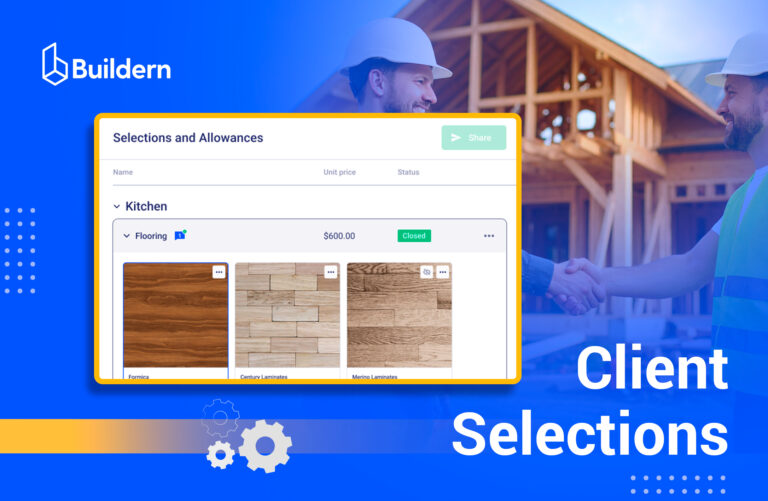
What ceiling materials or doors clients choose today can make or break a general contractor’s project in the future. Picking finishes, fixtures, and materials is a small part of a construction project. However, it is probably one of the most important parts for the client.
The general contractor also has the option to handle client selections manually or use a digital catalog to simplify the process.
In fact, this may be a phase of the construction when the client often changes decisions or makes multiple adjustments. This is the reason dealing with client selections requires much attention to detail and communication skills.
In this blog, I will show the pros of digitally managing different items and how to monitor changes in the construction management process.
Table of Contents
- What Are Construction Selections?
- Traditional Approach to Selections
- Key Features of Digital Selection Management
- Main Insights

What Are Construction Selections?
Items referring to the materials, fixtures, and finishes that homeowners choose for their project are listed as selections. These choices may seem like small details, but they have a significant role in the final say.
Why are clients so obsessed with this? Clients often focus intensely on fixtures and finishes because, while small in scale, these are the elements they interact with every day. Unlike such construction elements as walls or beams, finishes and fixtures shape the look of a home.
This is especially important for custom home owners who focus on the feel and functionality of their new home. Examples include flooring, countertops, cabinetry, lighting, plumbing fixtures, paint colors, and more.
Besides, client selections are closely linked to construction allowances and budgets. Homeowner’s choice has a cost implication, and exceeding the allowance can lead to budget adjustments or change orders.
Equally important is selections’ impact on timelines. Handling last-minute changes is one of the most painful parts of the general contractor’s job. However, if you have accurate tracking and timely approval, this will somehow minimize the harmful consequences of such decisions.
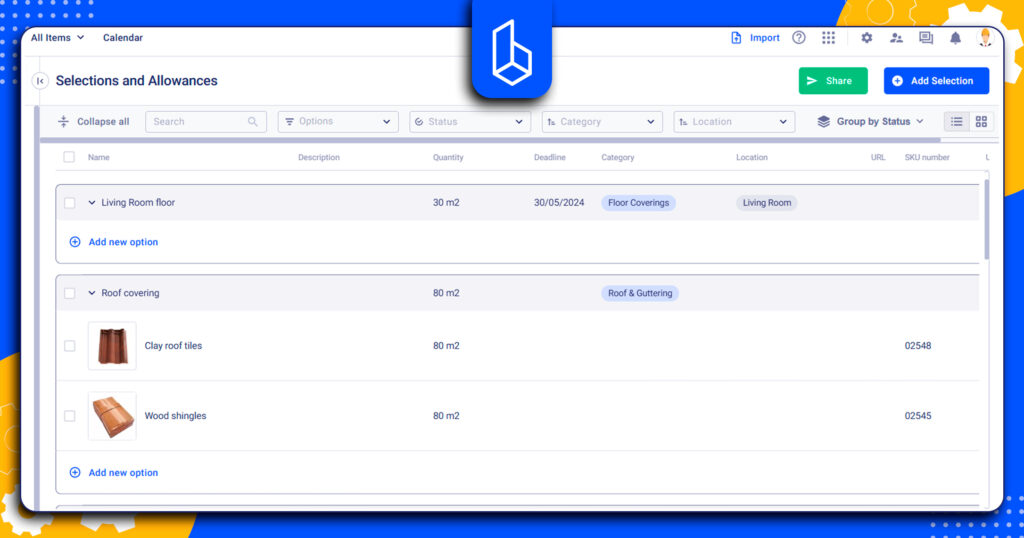
Traditional Approach to Selections
I remember when managing client selections often relied on spreadsheets, emails, and, earlier, on paper forms. This approach may have worked in the past. However, it comes with significant challenges.
Meanwhile, digital selection platforms offer a solution to these challenges. In this case, all client choices are in one secure platform, and teams can organize selections clearly and reduce the risk of errors.
Now I will point out some challenges that traditional client selection may lead to.
Challenges of Traditional Client Selections
Tracking multiple choices across projects can become confusing, especially when it comes to finishes, where dozens of colors and formats can be used for a single item. As a result, the construction company I am working with may have misplaced approval and repeated follow-ups. The problem is that a misunderstanding at one of the most crucial phases may harm the entire project.
Manual Tracking Using Different Channels
One of the key issues that may appear occurs when a builder relies on multiple communication channels. For example, it’s like having photos of kitchen tile samples in emails, later agreeing on the best via phone calls and text messages, or even handwritten notes.
Such an approach with mixing channels often leads to confusion and errors. In such cases, getting the final approval is difficult. The situation becomes even more complicated if a general contractor is managing several projects that involve multiple items.
Time-Consuming Follow-Ups and Document Management
Managing client selections often requires constant follow-ups to confirm choices. Gathering approvals or clarifying details takes a lot of time.
When using traditional ways to manage follow-ups, builders or project managers may spend hours each week to understand exactly which sink or wall color to choose. I happened to see how homeowners struggled to keep track of scattered images and tried to remember whether they sent the image via WhatsApp or email. The result is wasted time and frustrated clients.
Difficulty Keeping All Project Stakeholders Updated
Custom home construction projects typically involve multiple stakeholders. There are project managers, subcontractors, and field workers.
While decisions may be made in the office, field workers often face the greatest challenges if updates are not communicated clearly. Those who work on-site may be far from the decision-making process.
Such workers need precise guidance on where and how each selected detail should be installed. Thus, a general contractor should ensure that everyone has timely access to the latest selection information.
High Risk of Miscommunication
Experienced construction professionals may be aware of different models and details of the project. But there can be various assumptions about materials and finishes. It’s sometimes difficult to know what you meant when selecting some details.
For example, when I had a luxury home project, the client selected “marble countertops” during the design meeting. I wrongly interpreted this as standard marble at $60 per square foot, while the client expected marble at $180 per square foot.
This miscommunication may not be discovered at an earlier stage. It’s better to always show a visual and get approval as early as possible, so as not to damage the budget.

Key Features of Digital Selections Management
With so many challenges with traditional selection management, it’s better to choose the right digital tools to simplify the process. In addition to offering a visually appealing layout, financial management and communication are key here.
Centralized Selection Management
Besides visuals and prices, there are many other aspects that selections include. Centralized selection management allows contractors to keep every choice in one place. Every decision, big or small, is stored in a single, organized platform that both contractors and homeowners can easily access.
The main benefit here lies in alignment. When selections are centralized, there’s little room for misunderstandings or missed details. Everyone involved in the project, from subcontractors to site workers, can get the same updated information.
Flexibility in organization can help with easy navigation between hundreds of items. Selections can be grouped by deadlines, statuses, or even by specific locations in the project, such as the kitchen, bathroom, or living room. Having a cost catalog that lists items with visuals and descriptions helps here, as the items can be directly pulled from there.
This gives a contractor more valuable time to focus on improving the quality of the construction process without copying and pasting hundreds of items.
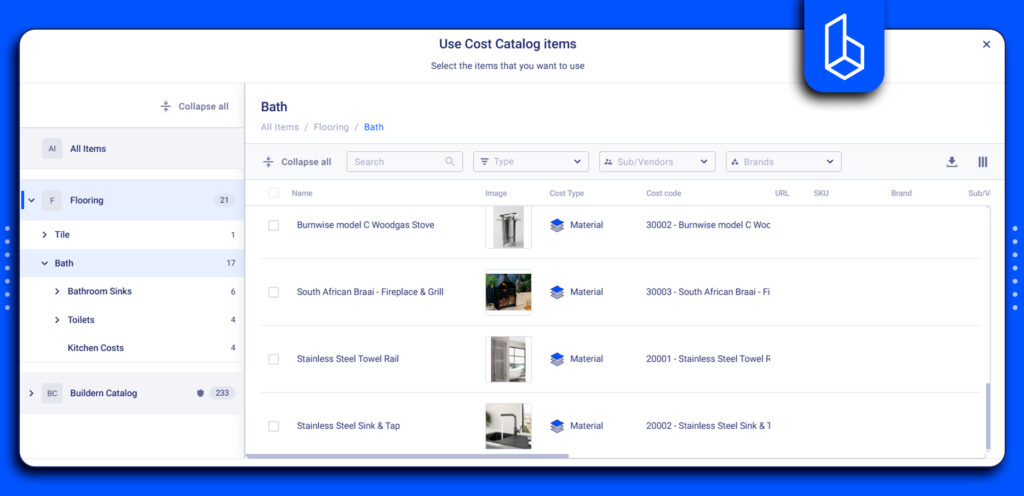
Client Engagement Tools
Having emails and messages in one place is a smart choice when it comes to client selections. The reason is that there will be no need to open different spreadsheets and look through information in different messengers and apps.
There is a possibility to select an item with its visual, short description, deadline, and other information. In the case of manual operation, the user has to download the data, enter an email, and attach the necessary files.
Using the communication tools of the construction management software means you do not have to switch to other channels. When sending a selection, the software automatically adds the emails used during the project, gives a template of an email. The user needs a few clicks to send the message instead of a long manual process.
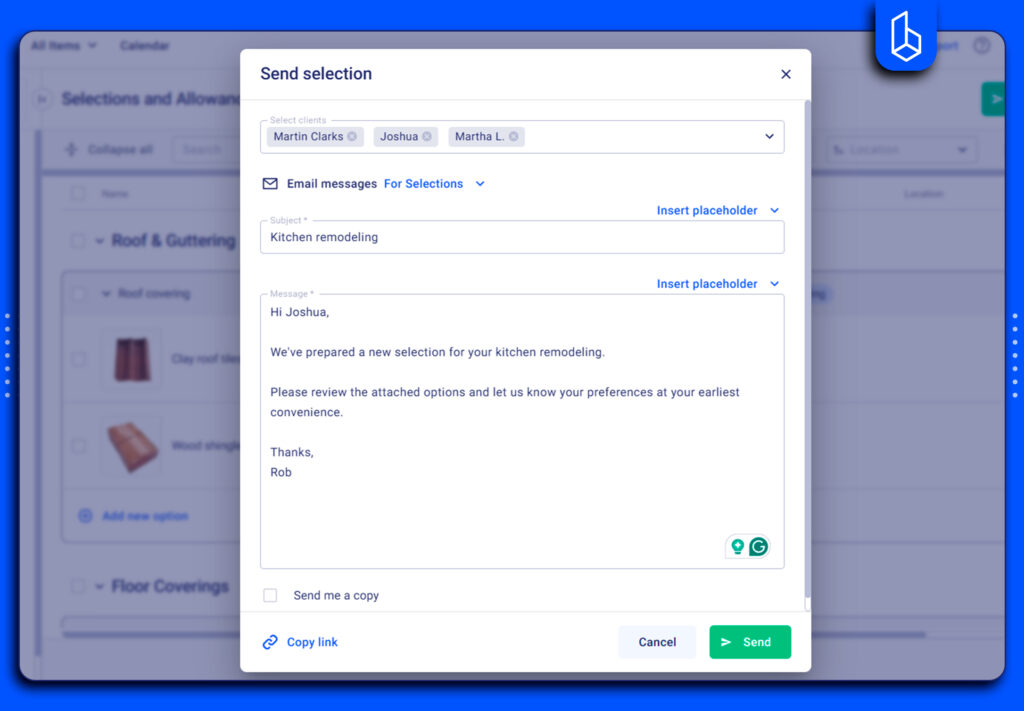
This may seem like a small detail, but think of dozens of times during, for example, a kitchen remodeling project. It all starts with the tiles and ends with cabinet handles.
One thing that I am sure will change your processes is that your client can review and approve selections within one platform. Thus, it’s easier to see the selected item, which can be automatically sent to a subcontractor or added to purchase orders.
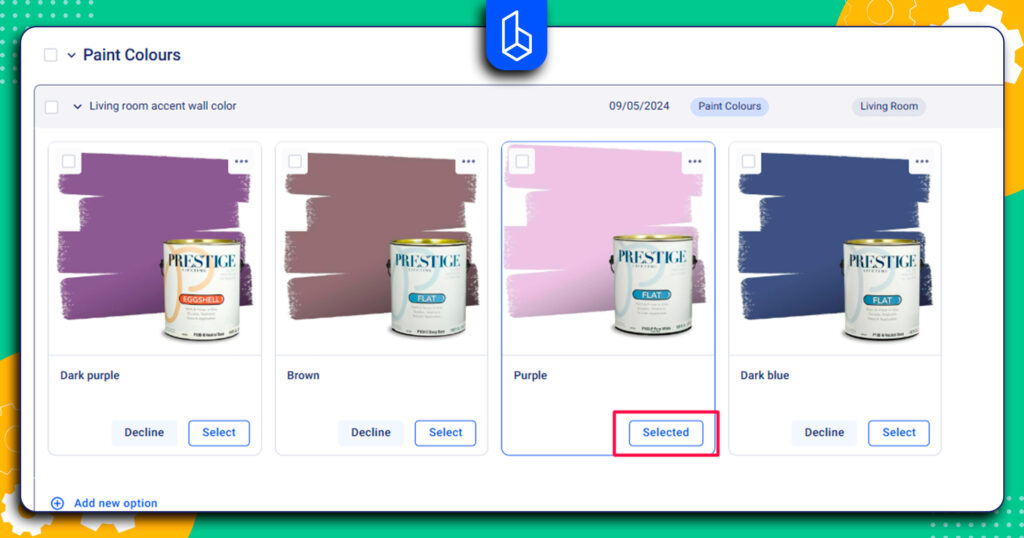
Financial Control and Tracking
One of the most common challenges in managing selections is keeping budgets under control. Without a clear system, the financial management of the project will not be efficient.
From what I have seen, a domino effect of overspending the budget is a significant issue. Going beyond the agreed budget means delaying progress, especially when approvals need to be renegotiated.
At first, small upgrades may seem harmless, but together they can quickly add thousands of dollars to the final bill. Adding allowances when creating an estimate will help prevent such issues as the project progresses.
For contractors, the more tools for tracking are identified, the less the risk of disputes and the more trust with clients. Instead of explaining overruns at the end of the project, the builder can point to a transparent record of every selection and its cost.
Deadline and Timeline Management
Digital tools offer a smarter way to keep timelines under control. Construction is an interconnected process, and every task is tied to the next.
It doesn’t matter whether it’s pouring the foundation or picking the right tile for the bathroom. If one step is delayed in your project, it triggers a chain reaction.
A late selection can postpone ordering materials, which in turn leaves subcontractors waiting, unable to move forward. Since trades often cannot replace each other in the schedule, one missed deadline can easily push back the entire project.
By integrating deadlines directly into the selection process, digital tools transform a construction management process into a structured, manageable workflow.
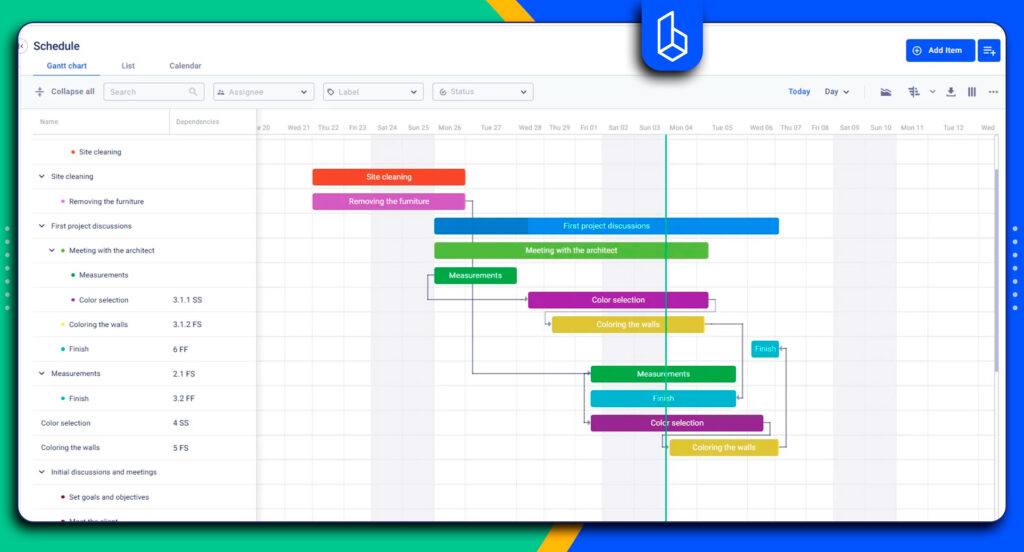
Why is Managing Client Selections So Challenging in Construction Projects?
A construction project contains hundreds of small details that need to be considered to avoid problems. Selections are about emotional decision-making, where clients focus on fixtures and finishes that will define their daily living experience. When clients change their minds about “small details,” it affects the project schedule.
How Does Digital Selection Management Prevent Budget Overruns?
Real-time cost tracking and automated allowance monitoring play an important role in preventing possible budget-related issues. Real-time visibility is important for making final decisions earlier without the risk of making mistakes. In the case of construction management software, the selected items are linked to budgets, invoices, and real-time costs are automated.
How Can I Improve the Selection Process with Digital Tools?
Software centralizes all client choices in one place. This means contractors, clients, and subcontractors always work from the same information. There are different tools in one; when all items can appear in the selections and later turn into purchase orders. Real-time updates, visual catalogs, allowances, and automated approvals ensure projects stay on track.
Main Insights
Having all selections available for a contractor and for a homeowner means having proactive control of the project.
During a construction project, much time is spent on finalizing details with a client. Chasing approvals and managing miscommunications is a part of the job. However, there are simple ways to save time on important processes.
By centralizing data in addition to automating financial tracking and bringing communication to one channel, contractors can focus on delivering quality construction. The result is happier clients, protected budgets, and projects that finish on time.

